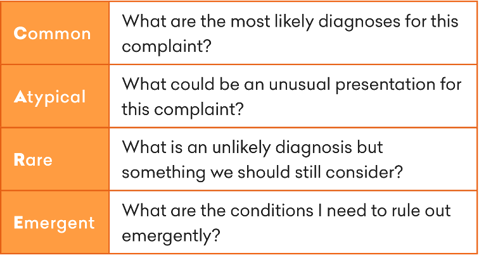How to Create Broad Differentials: Just CARE

Are you precepting an NP student this semester?
First of all, thank you! Precepting students is one of the most thankless jobs we have as NPs, but it’s so critical to our profession.
As an NP preceptor and NP educator, I want to equip you to be the best preceptor you can be. That’s why every month, I’ll be highlighting tips and tools for you to pass along to your NP students on the Hippo blog.
This month, let’s talk about differentials. One of my biggest struggles with my NP students is getting them to create a broad differential diagnosis. So I created a system for them to go through with each patient they see.
The tool is based on an acronym I learned in school to help make differentials: CARE.

Before my students go in to see a patient, I have them write down the CARE acronym on a piece of paper and write the differentials they were considering based on the patient’s chief complaint and a brief chart review. Walking through this acronym with them is a great way to understand their clinical reasoning skills and fill in any gaps they may have. One of the students I precepted recently told me that she mentally walks through the “CARE” acronym from this worksheet every time she sees a patient now that she’s a practicing NP!
A few tips when using this acronym:
- Diagnoses don’t have to fit into just one category! We want students to be thinking broadly about diagnoses, not necessarily categorizing them correctly right away. As long as the students is thinking about the differential, that’s a win in my book. One of my favorite NP instructors used to say to our class, “You’ll miss 100% of the diagnoses you don’t think about.” That saying has stuck with me throughout my NP career!
- Atypical presentations are challenging when you don’t have a lot of experience, so students may struggle with this category. That’s ok! This is where your clinical expertise comes in. I’ll never forget talking through this with a NP student while working in the ED. We had a young female patient who came in with R flank pain and I mentioned to her that an ectopic pregnancy would be under the atypical (and emergent!) categories for me. She didn’t even know that an ectopic pregnancy could present as flank pain. I only knew it because I had taken care of a patient with an ectopic who had presented with what I thought were symptoms of pyelonephritis.
- After your students list out their differentials, talk them through how they will use those differentials to guide the patient visit. What questions do they need to ask? What physical exams do they need to perform? What diagnostic studies are important to order to help rule in or out the differential diagnoses? Using your differentials to help guide their visit will help the students plan their time and resources well.
I hope you find this tool useful in your precepting! Keep up the excellent work training the next generation of NPs.
Practice-Changing Education
Experience education that goes beyond theory. Explore Hippo Education’s offerings below.


